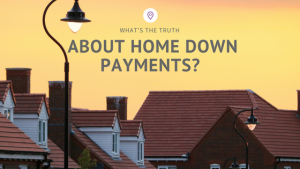What’s The Truth about Home Down Payments?

Separating fact from fiction in home buying can be difficult for you as a prospective buyer. The real estate market abounds with myths which could have you confused, particularly on the oft-repeated but false claim that you must place a 20 percent down payment on a home purchase.

The truth of the matter is that mortgage lenders generally don’t stick to that 20 percent benchmark anymore. Many of them have devised new loan programs allowing qualified borrowers to put in anywhere from 3.5 percent to no down payment on eligible properties
Aware of this new mortgage trend, you will be more confident in engaging the market in search of that dream home. You can likewise realize substantial savings and speed up the process of a home purchase, having identified which low or no-down-payment options are now available.
Down Payment Defined
Before learning of these options, it is necessary to first have a clear understanding of the definition of a down payment. Knowing the reason behind some lenders’ requirement or incentive for you to shell out a larger down payment is also important.
A down payment constitutes your initial funding for a home purchase. It is the amount of money that you can afford at the outset without resorting to borrowing. A larger down payment means that you would borrow a lesser amount. Consequently, you would have lower monthly amortization payments on the principal you owe and on its interest over the life of the loan.
Each mortgage program or lender sets a certain amount as down payment. If you have plenty of savings, you sure can allot a higher down payment. If not, you will need to at least come up with the minimum down payment required.
plenty of savings, you sure can allot a higher down payment. If not, you will need to at least come up with the minimum down payment required.
Dana Graham, a Realtor with the Rolling Hills, California-based Berkshire Hathaway California Properties, has an interesting take on down payments. She says that while a “down payment can be anything the lender will approve you at,” some lenders can actually look favorably on your mortgage application if you keep some funds in reserve. She elaborates: “At some point, the lender will put more value on you having a certain amount of rainy day money in your bank account.”
Many would-be home loan borrowers are still unaware of lenders having eased the old requirement of a 20 percent minimum down payment, according to Eric Meermann, a certified financial planner with Palisades Hudson Financial Group in Scarsdale, New York.

The relaxation of the 20 percent down payment policy, he says, is “good news for people who want to take advantage today of low-interest rates.” He adds that right now, “there are reasonable housing prices in many markets.”
Remember though, if you put a down payment below 20 percent, most conventional loan lenders require you pay for private mortgage insurance (PMI). These lenders require this insurance policy to protect themselves in case you default on your loan payment obligation.
There are ways of sidestepping the PMI though, which could be negotiated with a lender. Talk to your lender about such possibilities as a borrower-paid single premium. Typically, this will involve an upfront charge allowing you to buy out the PMI for the life of the loan. A piggyback mortgage is another way around the PMI, as it allows you the option for a second mortgage to partly cover the down payment, thus eliminating the need for PMI.
Less Could Be More and Here’s Why
Conventional wisdom dictates that a larger down payment is advantageous as it not only dispatches of the PMI but you also owe less during your loan’s tenure. Many experts maintain, though, that this borrowing tack may be dubious economics-wise.
Consider this opinion of Casey Fleming, a mortgage advisor with C2 Financial Corporation in San Francisco and author of The Loan Guide: How to Get the Best Possible Mortgage. He says: “The lower the down payment, the higher your return on investment if the home appreciates, and the greater the percentage loss if the home loses value.” With your down payment lower, he explains, your risk of a catastrophic loss is minimized “because you don’t have that much put into the investment.”
Furthermore, a low down payment makes you more liquid with more money and with accessible assets or accounts which could be tapped in case of emergencies. In contrast, once you have made the down payment on a home purchase, getting that money back or tapping your home’s equity can be difficult (unless of course, you sell the house).
Fleming concludes that an initial down payment could be “expensive and hard, if not impossible, to pull out of the home.”
Moreover, there is the risk that the value of your home could depreciate in the future. This means that if you put in a larger down payment today, there is this chance of having to keep a bad investment with a negative yield in the years ahead.
Popular Low- to No-Down Payment Loans
These mortgage loan programs are currently available and offer low- or no-down payment:
- FHA loan –3.5 percent minimum down payment
- Fannie Mae HomeReady loan–3 percent minimum down payment
- Freddie Mac Home Possible loan –3 percent minimum down payment
- VA loan – no down payment required
- USDA loan – no down payment required
- Conventional loan (with PMI) –3 percent minimum down payment
- Jumbo loan–10 percent minimum down payment

Additionally, David J. Hosterman, branch manager with Castle Cook Mortgage in Greenwood Village, Colorado, notes that there are many county, state and national grant programs providing down payment assistance to consumers who could not meet the required 3.5 percent or 3 percent down payment for Fannie Mae, Freddie Mac or FHA loans. Furthermore, Hosterman says that many of these programs cover not only first-time home buyers but also home buyers in general.
Who Got the Best Shot?
Home loan borrowers with secure income have the best shot at getting a low down payment, according to C2 Financial Corporation’s Fleming. He says these include buyers who:
 are less likely to lose their jobs or whose incomes are not entirely commission-based.
are less likely to lose their jobs or whose incomes are not entirely commission-based.- have plenty of savings left after closing, abundant reserves that could absorb a financial shock.
- observe healthy credit habits and do not overextend their credit-card limit, carrying either manageable revolving balances or none at all.
Raising the Required Cash
Be ready to bear some sacrifices to help fund your minimum down payment. Adopt alternative measures if needed, such as tightening your budget to the max through a strict and judicious planning.
“Scrimp and save,” counsels Berkshire Hathaway’s Graham. Forget that Mediterranean  cruise and a $200 dinner, she suggests, if you really want to be a homeowner and become so step by step.
cruise and a $200 dinner, she suggests, if you really want to be a homeowner and become so step by step.
Asking a friend or relative to assist financially through a gift for the home down payment is another consideration. Ensure though that your benefactor sends a letter to the lender to verify that the money you are getting is not a loan but a gift. If the amount you received from a friend or relative is a private loan, it may be denied for your down payment funding.
Lastly, seek the advice of an experienced mortgage specialist. This professional can help gauge your qualification or eligibility for a low- to no-down payment loan as well as help you adopt effective saving strategies.
I am always here to help too! Ask me your questions today!
-Melissa Tucci